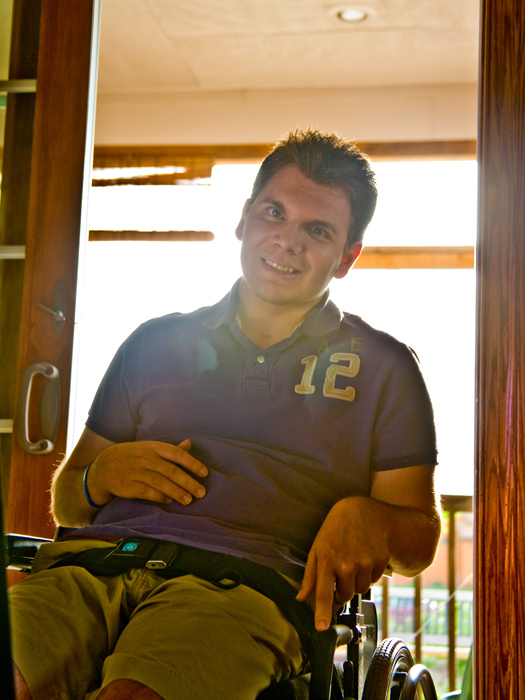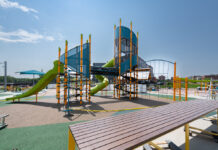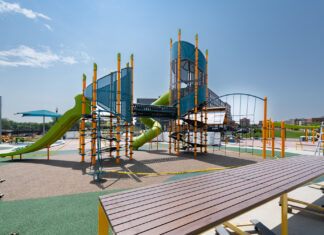By Andrew Sogn with additions by Alana Bowden.
Image by Candace Ann Photography.
I’m sitting in the living room of Ryan Bade and Karyl Mews, reminiscing on the past, taking time for Mews to tell me of how, when Ryan Bade was 20 years old, he had the world in front of him. A member of Phi Gamma Delta and a sophomore at the University of Minnesota-Twin Cities, Ryan was preparing for a career in mass communications or sociology and a future that would include marriage and, hopefully someday, children.
Ryan smiles constantly during the conversation, as if he remembers his glory days. The smile disappears though, when Mews tells the story of June 24, 2005; the worst day of her life, when Ryan was in a jet-ski accident that confined him to a wheelchair and with a traumatic brain injury. When he was hit, his parents, Mews and Greg Bade weren’t sure he would live.
“I can’t really put it into words what it was like when I got the news,” Mews said. “I was so scared, I didn’t know if he was going to live. And I’m thinking ‘oh Ryan, we need to say goodbye, but please, God, don’t make us say goodbye.’”
On the way up to a hospital in St. Cloud, Mews heard the news from an Intensive Care Unit (ICU) nurse that he was out of the emergency room and was on life support with very little brain activity.
“I tried repeatedly to say ‘The Lord's Prayer’ in my head, but the shock and horror of the nurse’s words wouldn't allow me to get it right,” Mews recalled. “I couldn't believe it. I've known that prayer forever.”
Perhaps with his mother’s faith and with the expertise of the medical team, Ryan survived. He now lives in Sioux Falls with Mews in a home that accommodates his needs.
“If you consider that he was on life support and very little brain activity and how he is now, it is amazing,” Mews said.
With the summer months in full force, stories like Ryan’s serve as a sad reminder of the dangers that a Saturday on the lake can bring.
According to ACE Recreational Marine Insurance, the most important thing you can do to be a safe boater is to “[a]lways wear a life jacket and insist that your crew and guests do the same.”
While Ryan was not one of the statistics, approximately 70 percent of all fatal boating accident victims drown, and over 90 percent of those drowned weren’t wearing life jackets.
“Thank God Ryan was wearing a life jacket,” Mews said. “He would have probably never survived otherwise.”
A second thing for boaters to do is to never drink alcohol. Many boaters don’t realize the danger of drinking while boating, but the concept of a BUI (Boating Under Influence), is the same as a DUI (driving under the influence).
Mews remembers asking Ryan not to mix drinking with water sports the night before the accident.
“I remember he was driving up to the cabin and he had called me. I knew the kids would be drinking at some point, but I asked him to be sure that if they were going to drink, they’d be off the water for the day and no one would be driving anywhere,” Mews said.
She still thinks about how the day could have turned out even worse if there had been drinking involved.
While drinking on a boat can be a relaxing and social event, it’s important to remember the danger alcohol presents. Research shows that four hours of boating, exposure to noise, vibration, sun, glare and wind produces fatigue that makes you act as if you were legally intoxicated. That, according to watersafety.org, can become deadly when you add alcohol to the conditions, because it “intensifies the effects and increases your accident risk.”
While driving under the influence is just as dangerous as boating with alcohol, recreational boaters need to remember boats don’t have brakes. In order to make up for that, it’s always important to remember to leave plenty of room for stopping. Just releasing the throttle or shutting off the engine will not immediately stop the boat. Boaters need to remain aware of their surroundings so accidents can be prevented.
A great way to increase safety is to have another person on board to help maintain a lookout, though it is not fool proof. Ryan’s near-fatal mistake came from him and others not maintaining a proper lookout. Two of his friends were in a boat riding alongside Ryan’s jet ski and were not paying close attention. One was enjoying the sun while the driver was looking at the depth finder, not paying attention to Ryan’s location.
“I was at Green Lake, near Spicer, Minnesota,” Ryan remembered. “I was driving a jet ski, and my friends were on the lake in a speedboat. And I was stopped on the jet ski, so I put it in park. But my friends in the speedboat were having fun on the hot summer day, and oops – they forgot where I was, and they hit my head.”
Ryan’s friends immediately called 911 and jumped into the water to pull his unconscious body onto the boat. A ground ambulance was waiting on the beach to transport him to a football field so a helicopter could take him to St. Cloud. Ryan was in a coma.
The American Boating Association asks all recreation boaters to BESAFE and know their “Boat, Equipment, Safety devices and PFDs, Alcohol limits, First aid and emergency procedures, and Environment (area and weather).” Ensuring proper safety could save a life.
An easy way to understand your watercraft better is to take a boating safety course, offered through the South Dakota Game Fish and Parks, and is offered online through www.gfp.sd.org.
Understanding the body of water is just as important as having a proper lookout, because some lakes can have sudden depth changes, and it is important to know where public boat ramps are, as well as other facilities available at the location, such as a ranger station, bathrooms, first aid centers, etc.
“Things can change so quick,” Mews said. “One minute those boys were loving life and enjoying a hot summer day, and in one split second tragedy struck, changing their lives forever.”
After Ryan woke up from the coma, his family was told he may never speak again, Ryan began to talk seven months after the accident – and that’s not all. They were also told Ryan may never be able to walk again, either. With the help of leg braces and a platform walker, Ryan is progressively making steps towards walking again.
“It is pretty amazing, the attitude he has,” Mews said.
Ryan’s life now consists of therapy three times per week, listening to music, watching TV and movies, attending church, going out to eat with his mother and her friends in order to be social, and most recently, getting back into the social networking world of Facebook.
Even with the lifestyle change and his accident’s five-year anniversary passing, Ryan continues to greet each day with a smile, making sure he has a positive outlook on what his days hold for him.
“Being in a wheelchair is different,” Ryan said. “I can’t do the stuff that I used to be able to do. But oh well. I guess you play the cards you are given. I have come to the realization that this is my life, so every day I just try to focus on the positives.”
To read more about Ryan’s story and for the latest updates, go to www.caringbridge.com and visit ryanbade.
















